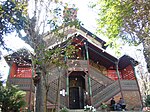19th arrondissement of Paris

The 19th arrondissement of Paris (XIXe arrondissement) is one of the 20 arrondissements of the capital city of France. In spoken French, this arrondissement is referred to as dix-neuvième. The arrondissement, known as Butte-Chaumont, is situated on the right bank of the River Seine. It is crossed by two canals, the Canal Saint-Denis and the Canal de l'Ourcq, which meet near the Parc de la Villette. The 19th arrondissement, mixing the Old French bohemianism and also the Parisian cosmopolitanism, includes two public parks: the Parc des Buttes Chaumont, located on a hill, and the Parc de la Villette, which is home to the Cité des Sciences et de l'Industrie, a museum and exhibition centre, the Conservatoire de Paris, one of the most renowned music schools in Europe, the Cabaret Sauvage, the Zénith de Paris and the Philharmonie de Paris, both part of the Cité de la Musique.
Excerpt from the Wikipedia article 19th arrondissement of Paris (License: CC BY-SA 3.0, Authors, Images).19th arrondissement of Paris
Avenue Alphand, Paris 19th Arrondissement (Paris)
Geographical coordinates (GPS) Address Nearby Places Show on map
Geographical coordinates (GPS)
| Latitude | Longitude |
|---|---|
| N 48.88222222 ° | E 2.38194444 ° |
Address
Avenue Alphand
Avenue Alphand
75019 Paris, 19th Arrondissement (Paris)
Ile-de-France, France
Open on Google Maps











